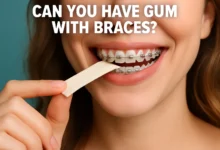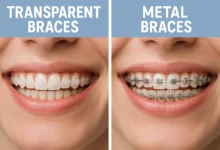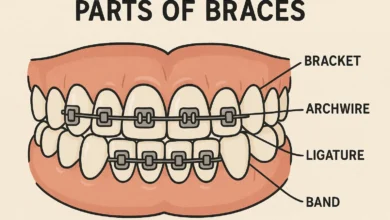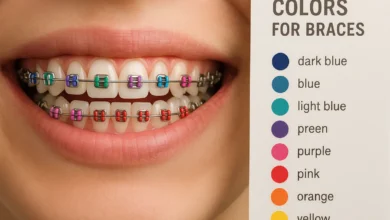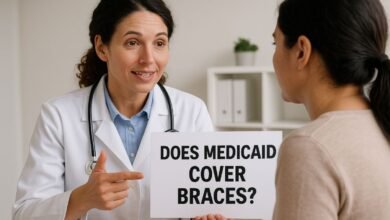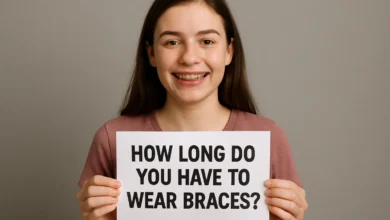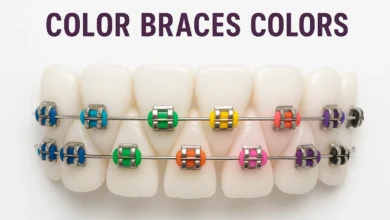Braces and Headgear Before and After: What to Expect from Treatment

Braces and Headgear: Everything You Need to Know About Orthodontic Correction
Introduction
Orthodontic treatment commonly produces mental images of metal brackets and wires together with rubber bands. Braces and headgear function together to treat serious bite misalignments and jaw growth problems in complex dental cases. Headgear remains an essential orthodontic tool which produces optimal results mainly for children and teenagers who are still growing.
This detailed guide explains the combination of braces and headgear in orthodontic treatment including patient requirements and headgear types and usage instructions and expected outcomes. This guide provides complete answers to all your questions whether you are a concerned parent or a patient beginning treatment.
1. What Are Braces and Headgear?

Both headgear and braces are orthodontic devices which aim to correct alignment and bite issues. While headgear assists in the alignment and growth of the upper and lower portion of the jaw, individual teeth are straightened using braces.
Braces:
Include brackets, wires, and bands
Apply constant pressure to move teeth
Typically worn for 18–36 months
Headgear:
Worn outside the mouth (usually around the head or neck)
Applies force to jaw bones
Usually worn in the early phases of treatment, especially in children
Used together, braces and headgear can treat complex dental problems more effectively than braces alone.
2. Why Are Braces and Headgear Used Together?

Braces are excellent at aligning teeth, but they can’t move jaw bones. That’s where headgear comes in.
Key Benefits of Combining Braces and Headgear:

Corrects severe overbites or underbites
Helps prevent jaw surgery in teens
Guides proper growth of the jaw
Improves facial symmetry
Reduces long-term wear on teeth
In many cases, braces and headgear together can prevent future complications and the need for more invasive procedures.
3. Conditions Treated with Braces and Headgear

The main purpose of braces and headgear is to address severe skeletal and dental misalignments which cannot be corrected by braces only.
Common Conditions Include:
Class II Malocclusion (Overbite): Upper jaw grows faster than lower jaw
Class III Malocclusion (Underbite): Lower jaw protrudes forward
Excessive Overjet: Top teeth protrude too far over the bottom
Open Bites: Teeth don’t close completely when the mouth is shut
Crowded teeth: Where extra space is needed to realign teeth properly
The combination of braces and headgear provides complete orthodontic correction by treating both tooth position and jaw structure simultaneously.
4. Who Needs Orthodontic Headgear?

Headgear serves everyone but doctors mainly recommend it for developing children and teenagers because their bones are still forming.
Ideal Candidates:
Children aged 7–14 with jaw growth issues
Teens with significant bite misalignments
Individuals looking to avoid orthognathic (jaw) surgery
Adults require headgear only in exceptional cases but at this stage bone growth is finished which restricts the potential outcomes.
5. Types of Orthodontic Headgear

Not all headgear is the same. The type you’re prescribed depends on your specific jaw issue.
1. Cervical Pull Headgear
Attaches to braces and wraps around the neck
Used to correct overbites by pulling the upper jaw backward
2. High Pull Headgear
Wraps around the back of the head
Helps control both jaw position and tooth growth
Common in open bite or protruding front teeth
3. Reverse Pull / Facemask Headgear
Pulls the upper jaw forward
Used for underbites (Class III malocclusion)
Typically used in younger children (ages 6–10)
The identification of your headgear type determines the effectiveness of braces and headgear treatment for your specific situation.
6. How Braces and Headgear Work Together
Orthodontic headgear doesn’t work in isolation—it’s attached to the braces using hooks, tubes, or bands.
How They Work as a System:
Braces move the teeth into alignment
Headgear applies targeted force to guide jaw growth or retraction
Together, they reshape the smile and bite holistically
The combination of these two elements enables braces and headgear to address both appearance and functional issues.
7. What to Expect When Wearing Headgear
Wearing headgear takes some getting used to, especially since it’s usually worn at home or during sleep.
What to Expect:
Initial discomfort or pressure (subsides in a few days)
Minor irritation around the face or neck straps
12–14 hours/day wear time recommended
Restrictions on physical activities while wearing it
Visible appliance if worn during the day (though many only wear it at night)
The adjustment period is short, but braces and headgear compliance is essential for fast, effective results.
8. How Long Do You Have to Wear Headgear with Braces?

Treatment duration varies depending on age and severity of misalignment.
Typical Timeline:
Mild cases: 3–6 months
Moderate cases: 6–12 months
Severe cases: 12–18 months
After this, braces continue the treatment until all teeth are properly aligned.
Orthodontists recommend starting braces and headgear treatment early to achieve efficient bone growth.
9. Care Tips for Braces and Headgear

To ensure successful treatment, you need to take good care of both your braces and headgear.
Daily Care Tips:
Clean the headgear regularly with warm water and mild soap
Brush and floss after every meal to avoid plaque around brackets
Remove headgear during meals and sports
Store in a protective case when not in use
Never adjust your headgear without orthodontist guidance
Proper care ensures both comfort and efficiency when using braces and headgear together.
10. Common Issues and How to Solve Them
Problem: Headgear Pain
Solution: Orthodontic wax should be used and OTC pain relievers should be taken while wearing the aligners in short intervals during the first week
Problem: Gum Irritation from Braces
Solution: Rinse with salt water, use orthodontic wax on sharp edges
Problem: Loose Bands or Connectors
Solution: Call your orthodontist; don’t attempt to fix it yourself
Regular checkups are vital when undergoing braces and headgear treatment to address any discomfort or complications early.
11. Lifestyle Adjustments During Treatment
Wearing headgear does come with some lifestyle changes, especially for children and teens.
Adjustments to Expect:
Limit sugary foods to avoid plaque around brackets
Avoid hard or sticky foods like popcorn or gum
Reduce contact sports or wear protection
Keep a consistent bedtime routine to wear headgear long enough
Although it may seem inconvenient, the payoff of braces and headgear is a lifetime of healthier smiles.
12. Before and After: Real Results from Braces and Headgear

The transformation achieved by combining braces and headgear is often dramatic.
Case Example 1:
Before: Severe Class II overbite in a 10-year-old
After 12 months: Perfect alignment and jaw correction without surgery
Case Example 2:
Before: Underbite in an 8-year-old
After 9 months of facemask headgear: Forward growth of upper jaw and normal bite
The results demonstrate that early braces and headgear treatment produces significant improvements in dental alignment.
13. Alternatives to Orthodontic Headgear
People who cannot or do not want to use headgear have other options available to them although these alternatives may not be as effective for growing patients.
Options Include:
Functional appliances like Herbst or Twin Block
Palatal expanders
Jaw surgery (in adults)
Temporary anchorage devices (TADs) for precise tooth movement
Still, for non-invasive, growth-guided correction, braces and headgear remain the gold standard.
14. FAQs About Braces and Headgear
Q1: Can adults wear headgear?
Yes, but results are more limited since the bones are fully developed.
Q2: Can I eat with headgear?
No, remove your headgear before eating to avoid damage or hygiene issues.
Q3: Is it painful to wear headgear?
Some discomfort is normal, especially during the first week. It gets easier over time.
Q4: How often should I wear it?
Most orthodontists recommend 12–14 hours/day, especially while sleeping.
Q5: Is it embarrassing to wear headgear?
It’s understandable to feel self-conscious, but most patients only wear it at home or at night. The long-term results are worth it.
15. Final Thoughts: Is Headgear Still Necessary in 2025?
The modern orthodontic field offers various new tools yet braces and headgear continue to serve as essential treatments for complex jaw alignment problems in young patients. The treatment method provides excellent long-term results at a low cost without requiring surgery.
Summary:
Braces move the teeth into alignment.
Headgear corrects jaw positioning and growth.
Worn together, they fix both function and aesthetics.
Your orthodontist will recommend headgear as a smart investment for your lifelong oral health rather than a punishment.
Braces at Age 8? Why Early Treatment Could Save Your Child’s Smile
